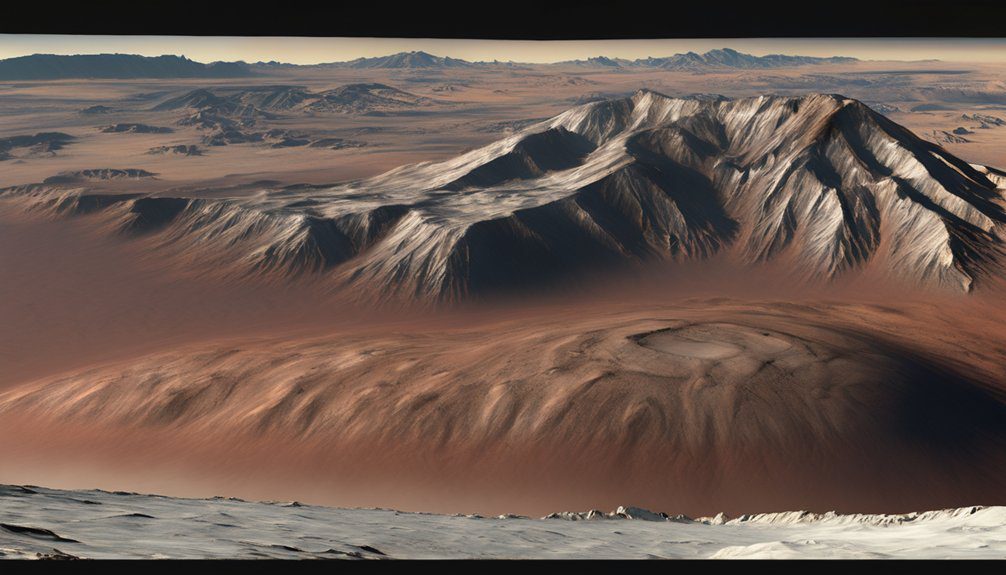Olympus Mons on Mars is the tallest mountain in the solar system, nearly three times taller than Earth’s highest peak, Mount Everest. It rises about 22 kilometers high and spans roughly 600 kilometers across, thanks to Mars’ lower gravity and lack of tectonic plate movement. Earth’s mountains are shorter due to tectonic activity and erosion. Understanding these differences reveals much about planetary geology and volcanic processes, setting the stage to explore deeper insights into mountain formation.
The Formation and Features of Olympus Mons
Although Olympus Mons is located on Mars, it provides a fascinating example of volcanic formation that differs considerably from those on Earth.
You’ll notice it’s a shield volcano, built by the slow flow of low-viscosity lava that spreads widely. Unlike Earth’s volcanoes, Olympus Mons lacks tectonic plate movement, allowing it to grow larger over millions of years.
Its base spans about 600 kilometers, and its height reaches nearly 22 kilometers, making it the tallest known mountain in the solar system.
The volcano features a caldera complex at its summit, formed by repeated collapse after eruptions, showcasing its unique geological history.
Comparing Olympus Mons With Earth’s Highest Mountains
When you compare Olympus Mons with Earth’s highest mountains, the differences in size and formation become immediately clear.
Olympus Mons towers about 22 kilometers high, nearly three times taller than Mount Everest, which reaches 8.8 kilometers. Its broad, shield-like shape results from repeated lava flows on Mars’s lower gravity and lack of tectonic activity.
In contrast, Earth’s tallest peaks form through tectonic plate collisions, creating rugged, jagged profiles. Additionally, Olympus Mons spans roughly 600 kilometers in diameter, dwarfing Earth’s mountains.
These contrasts highlight distinct geological processes shaping each planet’s surface, offering insight into planetary evolution and mountain development.
Environmental Factors Influencing Mountain Formation
The formation of mountains depends heavily on the environmental conditions present on a planet. You’ll find that factors such as gravity, atmospheric pressure, and tectonic activity play essential roles.
For example, Earth’s tectonic plates push against each other, creating mountain ranges. In contrast, Mars lacks active plate tectonics, allowing volcanic mountains like Olympus Mons to grow taller without collapsing. Additionally, lower gravity on Mars supports greater height.
Temperature variations and erosion also influence mountain shape and size. Understanding these conditions helps you appreciate why mountains form differently across planets, shaped by their unique environments and geological processes.
Scientific Discoveries and Future Exploration Plans
Since scientific discoveries have expanded our understanding of planetary geology, researchers have focused on exploring Olympus Mons and Earth’s tallest peaks through advanced technology and missions.
You can follow robotic probes and orbiters gathering data about Mars’ volcanic activity and Olympus Mons’ structure. On Earth, satellite imaging and climbing expeditions provide detailed information about mountain formation and erosion.
Future plans include deploying more sophisticated instruments to study Olympus Mons’ geology directly and comparing it to Earth’s peaks.
These efforts aim to reveal mysteries about planetary evolution and volcanic processes, offering you valuable insights into the dynamic forces shaping worlds beyond our own.
Frequently Asked Questions
How Long Would It Take to Climb Olympus Mons?
Climbing Olympus Mons could take weeks, but since it’s on Mars, you’d face extreme conditions, thin air, and no atmosphere. You’d need specialized gear and support, so it’s not a casual hike you’d just tackle.
Can Humans Survive at the Summit of Olympus Mons?
You can’t survive at Olympus Mons’ summit without a pressurized suit and oxygen because the atmosphere is super thin and temperatures plummet. But if you gear up right, you can explore and conquer that colossal peak your way.
Are There Any Signs of Life Near Olympus Mons?
You won’t find signs of life near Olympus Mons yet; Mars’ harsh environment and lack of liquid water make it tough. But keep exploring—future missions might uncover microbial traces hidden beneath the surface.
How Does Olympus Mons Affect Mars’ Weather?
Olympus Mons shapes Mars’ weather by influencing wind patterns and creating localized storms. You’ll notice how its massive height disrupts airflow, causing temperature shifts and occasional cloud formations near its slopes, adding dynamic variety to Mars’ climate.
What Tools Are Used to Measure Mountain Heights Remotely?
You use tools like radar altimeters, laser altimeters, and satellite imaging to measure mountain heights remotely. These let you explore Earth’s and other planets’ peaks without setting foot there, giving you freedom to discover from afar.






